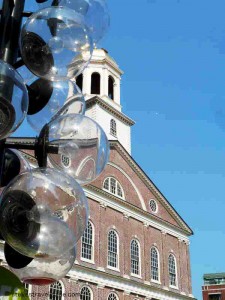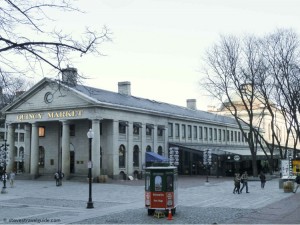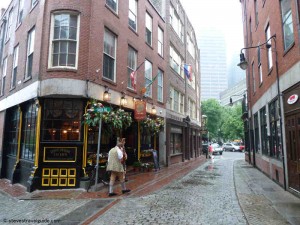Select your language to auto-translate:
The Cradle of Liberty
Given to the town by wealthy merchant Peter Faneuil in 1742, the Hall was host to many important Revolutionary-era meetings and events including speeches by James Otis and Samuel Adams, the establishment of the first Committee of Correspondence, and the first meeting to protest the tea tax that led to the Boston Tea Party.
Free The first floor is home to the National Park Service Visitor Center.
Open daily, 9-5 except during events; Ranger talks every thirty minutes.
Official website: http://www.nps.gov/bost/historyculture/fh.htm
617-242-5642
Handicap ramp and elevators are at the south side door near the Bostix booth. Enter through the Visitor Center.
Restrooms are in the basement and 2nd floor.
Public transportation: Green or Blue line to Government Center.
The Ancient and Honorable Artillery Company, the oldest chartered military organization in North America, has a museum on the 3rd floor. Website: http://www.ahac.us.com/
Be sure to attend the Ranger talk if your time permits. Allow at least 1/2 hour for your visit. The Quincy Market area next to Faneuil Hall is a good place to shop, eat, and wander. In nice weather there are street performers, and it is one of the most visited areas in Boston.
.
Background Information
As you approach Faneuil Hall from the Old State House, you will see a bronze statue of Samuel Adams (pictured above). This represents Adams as he defiantly confronted British Governor Hutchinson after the Boston Massacre. Before being moved here, the statue stood in Adams Square, which was demolished to create Government Center.
At the base of the statue, there are a number of markings in the pavement that represents the harbor’s water line in 1630. All the land from here to the current harbor has been filled-in.
Faneuil Hall was given to Boston by Peter Faneuil (1700-1743). Peter was the son of Benjamin and Anne Faneuil, wealthy French Huguenots(Protestants) who, along with Peter’s uncle Andrew, fled from religious persecution in 1685. Peter’s father died when he was 18. Uncle Andrew, a shrewd merchant and real estate investor, became one of the richest men in New England.
On his own, Peter became a successful merchant running a triangular trading operation shipping slaves from Africa to the West Indies in exchange for the molasses used to make New England rum. Boston and New England was the world’s largest rum producer during the colonial period.
In addition to his own success, Peter inherited a significant fortune from his Uncle Andrew. It is interesting to note that his Uncle’s estate came with the stipulation that Peter never marry. Peter accepted the conditions and remained a bachelor.
Uncle Andrew died in 1738 when Peter was thirty eight. Unfortunately, Peter was only able to enjoy his increased fortune for five more years as he was to die of dropsy (edema) when he was only 43. He did live well during his remaining time, living up to the name of one of his ships – The Jolly Bachelor. He left behind a cellar full of fine wine, cheese and beer.
The town’s decision to allow Faneuil Hall to be built was not without controversy. Even though Boston was a major seaport by the early 1700s, it did not have a large central market. Although a central market was a normal feature of English towns and would simplify things for most merchants, many vendors opposed developing the market. They believed that if their stalls were centrally located, it would lead to increased price competition.
In 1740, Peter proposed to build the central market for the town at his own expense. His proposal was not universally popular and passed by only seven votes, 367 to 360.
The original design had stalls facing out on all four sides – waterfront, fish market, hay market and sheep market. To help appease the opposition, Faneuil added a meeting hall above the market space.
Work began September 1740 and was completed in September 1742, only six months before Peter’s death. The first public use of Faneuil Hall was for Peter’s funeral, in March 1743. The building suffered a major fire in 1761. When it was rebuilt in 1762, the meeting hall was enlarged.
Quincy Hall & Faneuil Hall in 1838 (Note the Waterline)
Faneuil Hall received a major expansion between 1805 and 1806 based on Charles Bulfinch’s design. Both its height and width were doubled, and the cupola was moved to the opposite end of the building. The open arcades that served as the market areas were enclosed. Between 1898 and 1899 the building’s combustible materials were replaced.
One original fixture of the building is the grasshopper weather vane on top of the cupola. This was created by Shem Drowne, and is from copper and gold leaf with glass doorknobs for eyes. It was stolen in 1974, but was later found hidden in the cupola’s eaves wrapped in some old flags.
The grasshopper became such a Boston icon that it was used during the War of 1812 to screen for spies. If someone claimed to be from Boston and they did not know about the weathervane, they had to be a spy.
As a political venue, Faneuil Hall has more than earned the name “Cradle of Liberty”. During the Revolutionary period, it was the site of many important political events. In May of 1764 it hosted the first protest over the Sugar Act. Rallies were held here against the Stamp Act (1765), the Townshend Acts (1767), and the landing of British Troops that were sent to quell the associated disturbances (1768) – which ultimately led to the Boston Massacre in 1770. The funeral for Boston Massacre victims was held here.
Led by Samuel Adams, in 1772 the first Committee of Correspondence was established here. In 1773, Faneuil Hall hosted the first of the meetings to protest the tea tax. These meetings were so well attended they were moved to the Old South Meeting House.
During the British occupation in 1775 and 1776, it was a barracks for troops, then later a theater. In one incident, British General Burgoyne’s theatrical farce The Blockade of Boston was being performed at Faneuil Hall when it was interrupted by a small Patriot attack on Charlestown. It seems that the Patriots had learned of the play and precisely timed their attack to disturb the British performance.
After the war, Faneuil Hall continued to serve as a center of political activity. In the 1800s, it was a key rallying point in the anti-slavery movement, hosting abolitionists such as Wendell Phillips, William Lloyd Garrison and Frederick Douglas. Jefferson Davis, later president of Confederacy, spoke here in defense of slavery.
Faneuil Hall was also host to events in support of the women’s rights movement and temperance. It was the sight of John Fitzgerald Kennedy’s final campaign speech, made just prior to his election to the presidency in 1960. This tradition continues as the Hall hosts political debates and is a frequent campaign stop for both local and national politicians.
On third floor is the Armory Museum of the Ancient and Honorable Artillery Company. The Ancient & Honorable Artillery Company is the oldest chartered military organization in North America. Today largely ceremonial, it was founded in 1637 to protect the colony against Indian attack. The Armory, located here since it moved from the Town House (the predecessor to the Old State House) in 1746, holds relics from all periods of American history.
Quincy Market / Faneuil Hall Marketplace
When Boston incorporated as a city in 1822, the market around Faneuil Hall was not large enough to meet the city’s needs. Under the leadership of Boston’s second Mayor, Josiah Quincy III (a statue of Quincy stands outside of Old City Hall – Stop 6), Quincy Market was built to provide the additional market capacity. It was completed in 1826 and used initially as a foodstuff and produce shopping center. At the time of its construction, it was at the harbor’s edge. The North Market and South Market buildings, which stand on either side of Quincy Market, were built in the mid 1800’s.
By the middle 1970’s the whole area had deteriorated. It was revitalized as part of the preparations for the United States Bicentennial in 1976. Today, it is one of the busiest tourist destinations in Boston.
The Blackstone Block and the Holocaust Memorial
As you proceed down the Freedom Trail from Faneuil Hall (a left out of the front door), you will cross North Street and walk down Union Street towards the North End and the next Stop, the Paul Revere House. The intersection of North and Union Street begins the Blackstone Block – bounded by Union, North, Hanover, and Blackstone Streets. These streets were among the first streets to be laid out in Boston, and date from the 1600s.
On the grass mall just to left of Union Street, you will see the six glass towers of the Holocaust Memorial, established by survivors of the Nazi concentration camps. Each of the six towers represents one of the six primary Nazi concentration camps.
The towers are set on a black granite path, and glow at night. Each tower rises over a black chamber that emanates smoke from charred embers, creating an almost spiritual feeling. Six million numbers, suggesting the tattoos that were cut into those that perished during the Holocaust, are etched in glass.
This is a haunting and moving reminder of one of the greatest tragedies of our time.
You now cross Union Street from the Holocaust Memorial. The Union Oyster House on your right. The Union Oyster House is the oldest operating restaurant in the United States.
The Freedom Trail now winds down Marshall Street towards the North End. Marshall Street is one of the oldest and most authentically colonial streets remaining in Boston. On your right, just past the Green Dragon Tavern, is the Ebenezer Hancock House.
The Ebenezer Hancock House was built in 1767 by John Hancock’s uncle. John inherited it and gave it to his brother Ebenezer, who became the deputy paymaster of the Continental Army during the Revolution.
The Boston Stone, directly across from Ebenezer’s house, has been a landmark since 1737. A painter brought the stone from England to grind pigments prior to 1700. According to legend, it served as the “zero milestone,” used for measuring the distance to Boston – e.g., “20 miles to Boston” would mean 20 miles to this stone. The dome of the State House on Beacon Hill serves as Boston’s current zero milestone.
Proceed down Marshall Street, cross Hanover Street, and take a right towards to the North End. On Fridays and Saturdays you will pass through the Haymarket open-air market. There is a huge variety of fruits, vegetables, meats and seafood – all at bargain prices.
Haymarket Open Stall Market (open Friday & Saturday)
You may want to buy some berries to go with the pastries that will tempt you in the North End. Be careful of pickpockets.
Now cross through the Rose Kennedy Greenway to the North End. The Greenway is a series of parks that wind through the city covering the site of the Big Dig. An elevated highway used to bar the entrance to the North End (the trellis you see is at the height of the old highway). The Big Dig moved the highway (Route 93) underneath the city. So right now, you will be walking over Route 93


























[…] Stop 11 – Faneuil Hall. This is a great old and important building. Go inside and enjoy a Ranger-led talk (given every 30 minutes). Plan for 30-45 minutes to visit the Hall. The Faneuil Hall Marketplace (Quincy Market) is located next door, and is a good place to stop, get something to eat or shop. Plan accordingly. The new National Park Service visitor center is located in the first floor of Faneuil Hall. […]